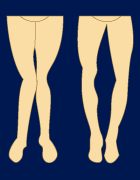Knee: The symptoms of knee osteoarthritis
The major clinical symptoms of osteoarthritis are pain and discomfort in movement. Symptoms appear for each affected joint, but their severity may vary depending on the latter. Onset of symptoms is usually gradual.
We talk about clinical signs (described here) and radiological signs (described in the radiological examination section). But the presence of clinical signs does not necessarily mean there are radiological signs. Hence, you can be suffering and your X-rays show only very slight osteoarthritic lesions and vice versa.
The symptoms of knee osteoarthritis are:
- Pain and difficulty in knee movements:
- Swelling
- Osteoarthritic deformities
- Other symptoms
- The specific symptoms of patellofemoral osteoarthritis
- The specific symptoms of femorotibial osteoarthritis
The pain of osteoarthritis can assume any intensity from very moderate to unbearable pain.
It is generally located in the arthritic area, the inner or outer side of the knee, but also, sometimes it is not directly related to the location of the osteoarthritis, particularly at the back of the knee (called the popliteal ).
The pain of osteoarthritis is primarily related to activity, walking and going up and down stairs exacerbated by being overweight and carrying heavy loads.
It usually decreases with rest, in a sitting or lying position.
It is sometimes accompanied by inflammation and wakes the patient up during the night.
But why does it hurt?
Some cases of pain-free osteoarthritis suddenly become quite painful, often from trauma or microtrauma.
Indeed, in osteoarthritis, it is the inflammatory reaction that is painful rather than the degeneration of the cartilage. This pain is found in mobilising the joint in question during a clinical examination.
Difficulty in your knee movements:
Limitation in certain movements depends most of all on the pain involved. Your knees are sensitive and lack flexibility. The ease and scope of your movements have decreased. Indeed, the functional impairment corresponds to the limitation in mobility of the joint affected by osteoarthritis. It varies depending on the activity of the person. Thus, an athlete will be much more bothered by osteoarthritis of the knee than a subject not practising a sport.
The synovial membrane of the knee irritated by cartilage debris and numerous inflammatory substances released during osteoarthritis, increases the production of an intra-articular lubricant called synovial fluid.
Its volume can sometimes be very significant and create substantial discomfort due to the excessive pressure it leads to (especially in the back of the knee). When the synovial effusion is significant it may be necessary to drain the fluid.
It is a combination of two processes.
One is the initial deformity responsible for the osteoarthritic mechanism, added to which is the deformity related to cartilage destruction. The latter can sometimes be very significant.
It can become irreversible and significantly deform the knee.
This is the only reason, aside from pain, which can impose the need for surgery.
Your general condition is always good. There is neither fever nor weight loss.
The following signs: crackling, a feeling of the joint being stuck and pseudo-blocking can create a lot of problems.
Pain:
It is caused by climbing stairs, kneeling or remaining in a sitting position for a prolonged period of time. The patella is sensitive to the touch.
Functional impairment:
It is often minor.
Functional impairment:
This form of osteoarthritis is debilitating because it gradually leads to a decrease in how far you can walk.
Pain:
It is triggered predominantly in the perimeter of the affected joint. The region of the internal and external side of the joint is very sensitive to touch, causing acute pain.
Deformities:
Two major deformities can be observed: the genu valgum (outer compartment affected) and the more common genu varum (inner compartment affected).







